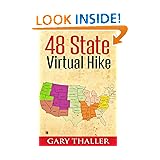Finally there is some beautiful mountain scenery on the virtual hike. It comes with a cost. The shoulder is often narrow in the direction of the walk. The walker can carefully walk with traffic where the shoulder is wider in most places. A few times the shoulder is narrow in both directions. In these cases it may be necessary to cross the road to avoid being on the inside of a blind curve. They should anticipate this and do it early so there is enough visibility to be able to cross early.
Yesterday, Danner sent me an email saying that some boots similar to the ones I have are on sale for $110. The only difference is these don't have a GoreTex liner, so they may not be as waterproof. Since I don't need waterproof boots most of the time, I ordered them.
Shoes can be expensive. If a pair that lasts 400 miles costs $49.95, the cost is 12.4 cents a mile. So far my other pair of combat boots have lasted over 2,800 miles and the cost was $135. If these last the same number of miles, the cost would be 3.9 cents a mile. It doesn't sound like much on a daily basis, but the savings over the whole route would be about $722.
The increased cost would be worth it if light shoes were more comfortable or I could walk faster in them. But light shoes lose on both counts. I'm not trying to convince everyone they should buy combat boots, but they are worth considering. I've never seen anyone else recommend them outside of military circles. If you do consider combat boots, spend hours reading reviews on Amazon and on the manufacturers website. There is a considerable difference between brands and boots within the brands. Some are "garrison boots" which are designed for comfort in an office environment.
There are few places along the route to buy anything but box store brands of shoes. Even if the walker finds a good shoe store, they may have trouble finding a shoe in stock in their size and type of shoe they like.
On a reality hike, I'd take two pairs of shoes. I'd wear one pair two days for every day I wore the other pair so one would get ahead of the other in wear. Once the first pair wore out, I'd alternate days after I got the second pair. Alternating days gives time for the shoe to dry out completely between uses. This can reduce the probability of fungal infections. It also makes the shoes last longer, at least in those shoes where the top is the first thing to wear out.
Alternating days is a good idea for virtual hiking for the same reason.
Yesterday I was at Home Depot buying some alcohol for the stove. While I was there I bought a five gallon bucket and lid to sit on. It will also keep clothes dry. It takes up a good bit of space in the cart, but if the bucket is full, it doesn't matter. I think this will be the only luxury item I get for road walking.
A bucket is somewhat of a necessity. It's hard to find a place near the road to cook and eat that is both out of view of the road and has a place to sit. I don't like to be visible from the road during breaks as I don't want to be mistaken for a hitchhiker which can create problems in many states. Fortunately, in Colorado, hitchhiking is legal. Still, it's better not to attract attention.
One key to completing this hike is to rest during rest periods. Standing takes more energy than walking, so a standing rest doesn't accomplish much. The general rule for backpackers is to keep short rest breaks under ten minutes. If it's going to be longer than ten minutes, then rest a half hour. The reason is muscles will be stiffer if the rest is between 10 and 30 minutes.. This is only a guide, and each individual will be different.
Food
I haven't said much about food on this blog. This is a typical lunch for me. Note the bowl is a family size serving bowl. It's about four or five "normal" servings.
See you down the road,
Gershon




No comments:
Post a Comment